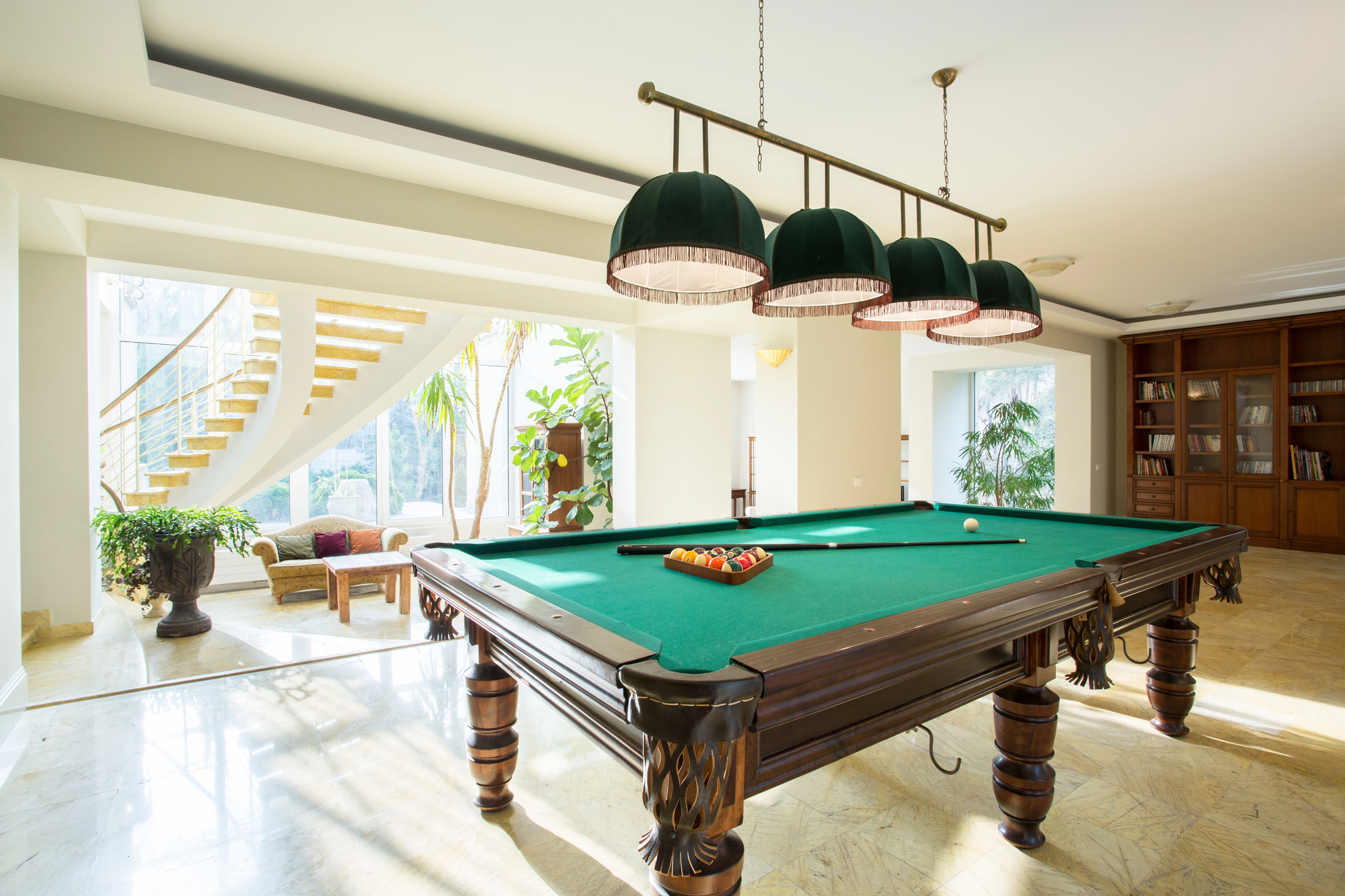There was a time when the words “game room” brought to mind a space hidden away from the main living areas. Basements, attics, or spare rooms were converted into hobby spaces that rarely matched the home’s overall aesthetic. Function took priority over form, and style was rarely a consideration.
Often, these rooms were designed purely for entertainment, with little thought for atmosphere or cohesion. Thick carpets, neon signs, and mismatched furniture created a sense of nostalgia but also a visual disconnect from the rest of the home. They served their purpose but felt isolated.
The activities themselves were timeless. Playing pool, darts, or classic arcade games appealed to all ages. However, the surroundings did little to elevate the experience, making leisure feel like an afterthought rather than a lifestyle choice.
This reinvention reflects a broader cultural evolution in how we define luxury. As Vogue Living highlights the rise of “quiet luxury” in interiors, true luxury is no longer defined solely by rare materials or cost but by the thoughtfulness with which a space supports daily life. In leisure design, this translates into environments that are understated yet purposeful, where every material, fixture, and piece of furniture is chosen with intent. A games lounge no longer stands apart as a novelty but participates in the same aesthetic dialogue as the kitchen or the living room. The focus has shifted from excess to integration, from spectacle to atmosphere.
Over time, design expectations began to shift. Homeowners wanted spaces that could be enjoyed by guests and family alike, without compromising on appearance. Leisure areas began to be seen as part of the home’s identity, rather than an annexe to it.
This shift accelerated as people spent more time at home. The boundaries between work, relaxation, and play blurred, leading to a greater desire for multipurpose spaces that felt both comfortable and stylish. A leisure area could no longer be tucked away without consideration for its design.
Today, these spaces receive the same design attention as kitchens or living rooms. Positioned prominently within the home, they invite people to gather, play, and interact. Their role is fully integrated into daily living.
The modern approach embraces the idea that a leisure space should add to the home’s character. Its visual and functional qualities should be in balance, ensuring it feels essential rather than optional. The “hidden game room” has been replaced by something much more intentional.
Furniture – Designed to fit
The modern leisure product is no longer purely functional. It is a statement piece, designed to bring as much to the room visually as it does in terms of entertainment.
Pool tables have undergone perhaps the most dramatic transformation. Many now feature rich woods, brushed metals, or leather detailing. They can be customised to match a specific palette, ensuring they suit the interior as well as the activity.
Elegant luxury pool tables elevate the very concept of home leisure, merging visual refinement with play. They introduce a sense of theatre into the domestic space, drawing people together as much through their presence as through the games they host. In contemporary interiors, they serve both as canvases of material artistry and as catalysts for conviviality, reminding us that leisure is most rewarding when it is as beautiful as it is engaging.
Arcade cabinets have also evolved. Their finishes are often sleek and minimalist, with muted tones and integrated controls. They can stand as decorative pieces even when not in use.
Board-game furniture is gaining popularity. Tables with hidden compartments, removable tops, and built-in lighting offer flexibility without sacrificing style. They invite play while remaining functional day-to-day.
Treating these products as art means they are chosen with the same care as a designer sofa or dining table. The emphasis is on craftsmanship, materials, and longevity.
This approach strengthens the bond between the owner and the piece. Owners are more likely to care for and keep these pieces, integrating them into the evolving story of the home.
Leisure furniture of this calibre also carries a social dimension. These pieces often become conversation starters, bridging generations and creating shared experiences in a way that few other home features can.
Trend shift: From functional to intentional – Leisure as design
The shift from functional to intentional leisure reflects a broader cultural change. Homeowners now see every part of their living environment as an opportunity for expression. Recreation is no longer confined to a spare room; it is woven into the home’s design narrative.
In the past, leisure furniture was purchased for durability and use, with appearance an afterthought. Now, materials, finishes, and proportions are just as important as playability. The look of the item is considered from the start.
Lifestyle changes have played a role in this evolution. More time spent at home has made people aware of how their surroundings affect their mood and productivity. Leisure spaces must now be as pleasant to look at as they are to use.
Pool tables are a clear example of this transformation. No longer heavy, dark, and visually dominant, they can be light, minimalist, and designed to blend seamlessly with the rest of the room. Their colours and materials are chosen to complement the space.
The rise of multifunctional spaces has also driven demand for adaptable leisure products. A table might double as a dining surface or fold away when not in use. This makes them practical for smaller homes while remaining adaptable in larger ones.
Social interaction is another key driver. A well-designed leisure area can serve as a natural gathering point, encouraging conversation and shared experiences. As Elle Decor notes in its feature on designing rooms that bring people together, spaces planned with inviting seating, open sight lines, and shared focal points naturally encourage connection.
Balance remains the guiding principle. The aim is to create a space that feels inviting yet visually harmonious. Every element, from lighting to storage, contributes to this atmosphere.
Designers are also responding to a growing appetite for personalisation. Homeowners want leisure spaces that reflect their personalities, whether through custom finishes, tailored layouts, or hand-picked accessories. This adds another layer of intentionality to the design process.
Interior designers & architects: Reimagining entertainment through form and finish
Interior designers and architects now treat leisure as a design feature rather than a side note. Their goal is to make these elements part of the home’s architectural and stylistic flow, not isolated components.
Projects often start with the leisure element in mind. A central space might be designed to accommodate a games table, with natural light and considered sight lines. This elevates the object to a focal point rather than an afterthought.
Attention to detail is crucial. Flooring is selected for both durability and beauty, while lighting is chosen to set the mood and ensure functionality. Every detail is coordinated to create a cohesive result.
Brands like The Game Room Company, Fusiontables, and Aramith have adapted to this new demand. They produce items that satisfy both performance and aesthetic requirements, recognising that homeowners expect both.
Architectural planning ensures that leisure spaces fit naturally into the home. Proportion, alignment, and integration with surrounding furniture are all considered to prevent the leisure element from feeling intrusive.
Hospitality design influences are common. Many leisure areas now resemble boutique hotel lounges, with layered lighting, comfortable seating, and curated décor. The emphasis is on creating a space people want to spend time in.
Acoustic considerations are also important. Designers think about how sound travels, ensuring that the space works for both lively games and quieter moments. This attention to sensory experience enhances the overall appeal.
The expansion of leisure design has also inspired a blending of traditional and modern elements. Classic craftsmanship techniques meet contemporary forms, producing pieces that appeal across generations. This fusion is part of why the reimagined leisure space feels enduring rather than fleeting.
A design philosophy: Blending materials, modularity, tactile elegance
The best leisure spaces are guided by clear design principles. They prioritise quality materials, adaptability, and sensory appeal. Each decision is made with both longevity and user experience in mind.
Modularity is a defining feature of many modern leisure products. Tables that convert from dining to gaming surfaces, or furniture that incorporates concealed storage, allow for multifunctional use without compromising on style.
Material choice is equally important. Wood brings warmth and a natural patina over time. Metals add strength and a contemporary edge. Fabrics introduce comfort and texture, making the space inviting.
Home Games Room is a UK-based home leisure brand designing entertainment furniture that blends luxury with utility. Its approach reflects the growing demand for pieces that are as practical as they are beautiful.
Tactile qualities enhance the pleasure of use. A leather edge on a pool table, the cool touch of a polished metal fitting, or the satisfying weight of a game piece all contribute to a richer playing experience.
Design integration is essential. Every piece should relate to its surroundings, in scale, colour, and style. This ensures the space feels harmonious and intentional.
Sustainability is also entering the conversation. Many homeowners now prefer to invest in durable, timeless pieces that will not need to be replaced frequently. It’s part of a broader cultural move towards conscious consumption.
By blending these elements, designers create leisure spaces that stand the test of time. They remain adaptable to changing needs and styles, ensuring they continue to bring value for years to come.
Product as art:
Pool tables, arcade setups, and even finely crafted board-game furniture have evolved beyond function. They are now approached as design objects in their own right — pieces that can stand proudly alongside sofas, dining tables, or lighting installations. The craftsmanship, materials, and scale allow them to act as both entertainment hubs and visual anchors within a room. When integrated with care, they enrich the aesthetic rather than disrupt it.
Imagine a London flat where the games area is not tucked away, but visible from the main living space. The design is clean and intentional, with pale oak flooring running seamlessly from the sitting room into the leisure zone. The result is visual continuity. The leisure area feels connected rather than set apart.
Increasingly, leisure pieces are conceived as collectible design objects that sit comfortably between furniture and art. Architectural Digest has observed that leading makers are blurring the line between art and furniture, treating proportion, materiality and finish as the core brief rather than afterthoughts. In that context, an elegant pool table reads less like equipment and more like a sculptural focal point.
A compact seating arrangement offers a place for guests to relax between games. Low armchairs and a small side table create an informal yet elegant gathering spot. The arrangement encourages conversation and interaction, even for those not actively playing.
A vintage chess table occupies the far corner. Its surface is inlaid with fine marquetry, while drawers hold neatly stored pieces. When not in use, it serves as a side table, holding books or drinks in understated style.
Storage is discreet and integrated. Cue racks are flush-mounted into the wall panelling, and built-in drawers under the seating store spare cues, chalk, and balls. The absence of clutter reinforces the sense of calm order.
The entire layout is designed to maximise the usability of the space without compromising its aesthetic. The games area feels as much a part of the home as the kitchen or dining room, not a separate, mismatched add-on.
This kind of design also adapts seamlessly to different occasions. It works as well for a quiet evening of chess as it does for a lively pool tournament with friends, a versatility that adds to its appeal in a modern home.
It’s a clear example of how leisure can blend naturally into sophisticated interiors. It shows that play need not be relegated to a hidden room, but can stand proudly as part of the home’s public spaces.
Analogue play and digital detox: Balancing attention, conversation, dopamine
One of the most compelling aspects of analogue leisure is its ability to offer relief from constant digital engagement. In a world where screens dominate work, entertainment, and even social interaction, physical games provide a refreshing alternative.
The sensory qualities of analogue play cannot be replicated on a screen. The weight of a snooker ball, the smooth glide of a chess piece, or the shuffle of playing cards engages touch in a way that digital interfaces cannot. These tactile details draw people in, making play feel present and absorbing.
These activities create natural opportunities for conversation, with players interacting face-to-face and reading body language as well as tone. The result is a connection that feels richer and more grounded than online exchanges.
Another benefit is the way analogue games impose a rhythm. They have a start, a middle, and an end, creating natural breaks that avoid the endless scroll or replay cycle common in digital media. As Psychology Today explains, our “analog minds” can struggle when screen-based activities constantly fragment attention. Tactile, structured play provides a valuable counterbalance.
Leisure spaces designed for analogue play can further enhance these benefits. Comfortable seating, warm lighting, and thoughtful acoustics make it easier to focus on the activity and the people involved. The environment supports presence.
Importantly, analogue play is not positioned as a rejection of technology. Instead, it provides balance. It allows individuals and families to step away from screens without feeling deprived of entertainment.
These moments of connection and focus can have a restorative effect. They encourage mindfulness, patience, and an appreciation of shared time. This makes them valuable not just for enjoyment, but for overall well-being.
When integrated into the home in an appealing, design-conscious way, analogue leisure becomes a natural part of daily life. It transforms from a special occasion into a regular ritual.
Style, substance, and shared moments – Home leisure redefined
The reimagining of home leisure reflects a shift in how we live. Recreation is no longer an isolated activity hidden from view, but an integral part of our living environments. Design-led leisure spaces invite use while enhancing the home’s atmosphere.
These spaces prove that beauty and function can coexist. They suit both quiet moments and lively gatherings, adapting naturally to the changing rhythms of daily life.
Investment in quality pieces ensures that these areas remain relevant over time. They are not trends, but enduring features that evolve with their owners.
Modern home leisure design delivers more than entertainment by creating spaces that support interaction, focus, and pleasure. It offers a richer, more connected way of living.
Play has become an expression of lifestyle, as intrinsic to the home as its kitchen or library, and just as reflective of personal taste. It reflects values, tastes, and the importance of shared experience.
In this sense, style and substance do not meet in opposition, but in partnership. The result is a home that feels alive, dynamic, and deeply personal.
The future of home leisure lies in a seamless union of design and play. It reminds us that living well depends as much on the moments we create as on the spaces that shape them.
DISCLAIMER – “Views Expressed Disclaimer – The information provided in this content is intended for general informational purposes only and should not be considered financial, investment, legal, tax, or health advice, nor relied upon as a substitute for professional guidance tailored to your personal circumstances. The opinions expressed are solely those of the author and do not necessarily represent the views of any other individual, organization, agency, employer, or company, including NEO CYMED PUBLISHING LIMITED (operating under the name Cyprus-Mail).







Click here to change your cookie preferences